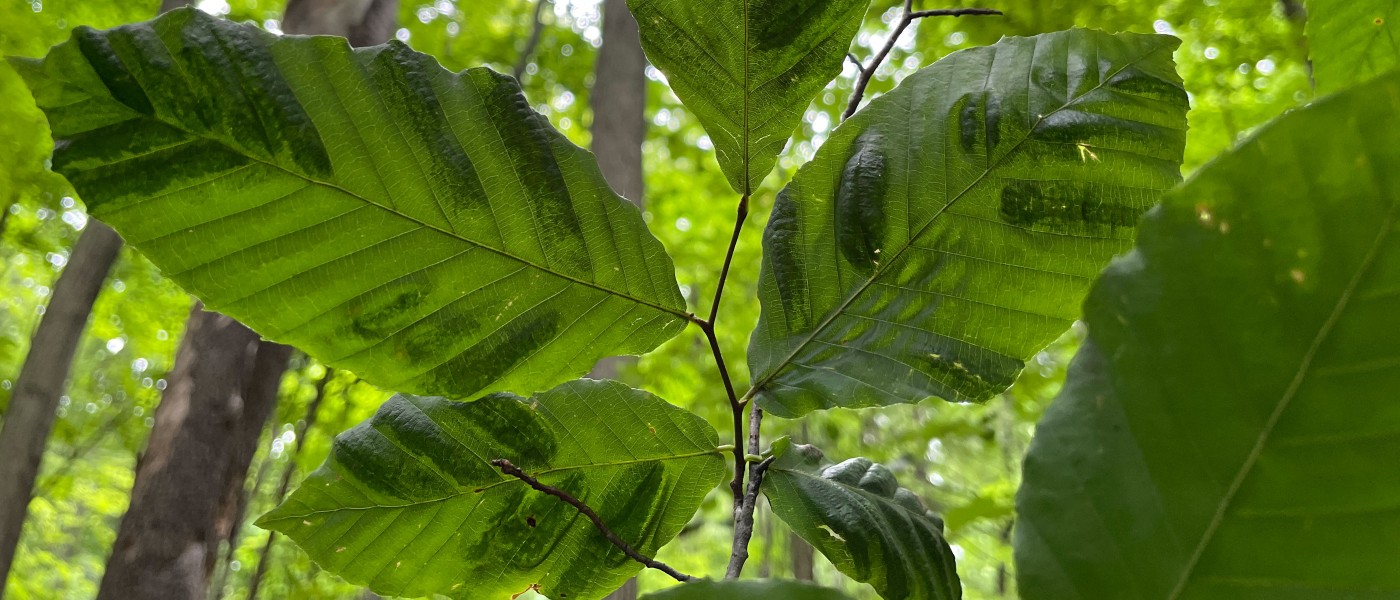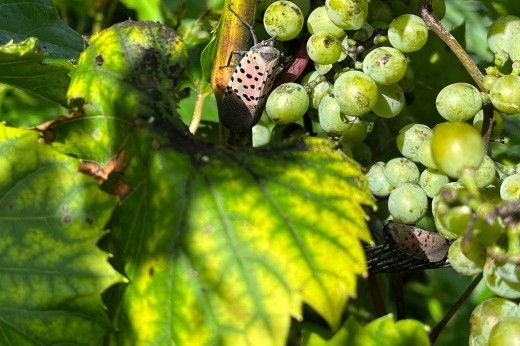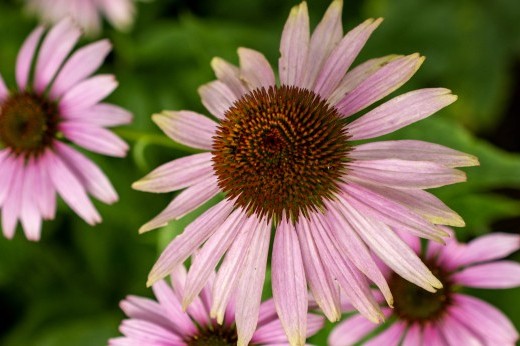In 2020, two of the largest beech trees at Brooklyn Botanic Garden, both about 100 years old, began to exhibit distinctive dark stripes on their leaves. The following year, similar symptoms began to show up on other beech trees nearby in Bluebell Wood, which houses BBG’s beech, elm, and birch collection.

These striped leaves were later confirmed to be a sign of beech leaf disease, which kills both native and ornamental beech species. Beech leaf disease, also called BLD, was first identified in Lake County, Ohio in 2012, and has since been found in 15 states in the Eastern U.S. as well as Canada. Scientists are still learning about this novel disease, but—like other major tree diseases and infestations we’ve seen in recent years, from the emerald ash borer to oak wilt—it is believed to pose a serious threat to both ornamental landscape trees and forest ecosystems.
We spoke with BBG staff and collaborators and other experts to learn more about beech trees, how this disease is affecting them, and how researchers are working to mitigate its impacts.
What are beech trees?
In New York City, you’re most likely to encounter beech trees in parks and gardens, since they don’t do well in street tree beds. They can grow enormously large. Their ovate, serrated leaves turn a brilliant golden yellow in the fall, and their smooth gray bark sometimes gets compared to elephant skin. BBG has several different species, including European beech (Fagus sylvatica) and its cultivars and the native American beech (Fagus grandifolia).
The American beech is a dominant species in the northern hardwood forests of Eastern North America. They can live for up to 250 years and have been found to grow as tall as 160 feet. Their small, nutrient-dense nuts are critically important for wildlife, including bears, deer, turkeys, squirrels, blue jays, and many other animals.
Beech trees, like other trees, also provide resources and medicine, hold cultural memories, clean the air, reduce stress, and sequester carbon, along with numerous other crucial tasks.
“These large trees help people breathe in cities,” says Chenae Bullock, a member of the Shinnecock Indian Nation whose Native Flora Garden tour Ohkehteau (Plants of the Earth): A Shinnecock Oral History explores the importance of beeches and other native plants and their use by Shinnecock people.
What is beech leaf disease, and what does it look like?
Beech leaf disease is associated with a nematode (Litylenchus crenatae ssp. mcannii), a microscopic worm, that feeds on and damages beech leaves and buds. The nematode is believed to be an invasive species.
Beech leaf disease is not to be confused with beech bark disease, another disease that affects beeches, though the combined effect of these two diseases is likely putting additional pressure on trees in some areas.
Many plant diseases can be hard to diagnose on sight, but BLD produces a signature dark banding, or striping, symptom between the secondary veins of leaves that is easy to recognize. As the disease progresses, leaves may also become leathery and shrunken.




A number of beech species have been found to be susceptible, though BLD appears to have particularly severe impact on American beech trees. It also disproportionately impacts saplings, which typically die within five years of infection, while larger trees take longer to decline.
If you walk into a forest of infected beeches, you may notice that lower leaves are more affected than leaves higher up. Researchers speculate that this could be because the nematode flourishes in the moister, shadier areas lower in the canopy.
How does the disease work?
Researchers have observed that the nematodes move out of the leaves and into the buds in fall, where they overwinter and multiply.

“We started out being all fascinated by what was going on in the leaves, and it’s almost irrelevant,” says Margery Daughtrey, a plant pathologist and senior extension associate at Cornell University. “We were so shocked when we first opened up buds in the winter and looked and saw hundreds of nematodes between two bud scales.”
In a moderate infestation, the nematodes’ presence damages the buds, producing those distinctive banded leaves that are seen in spring. In a more severe infestation, or on a more stressed tree, the buds can be killed. It’s the death of the buds that is particularly harmful to beech trees, because this prevents the tree from leafing out normally, restricting its ability to feed itself through photosynthesis.
How does it spread?
Researchers don’t know for sure, but BLD seems to spread very easily, rather than relying on a single pathway or vector. It is likely dispersing through wind and rain, and it might get moved around by birds or insects, too. It can also move in nursery stock.
There are no quarantines on beech currently in place within the United States, but experts recommend that you not transport beech materials (meaning branches, twigs, soil, leaves, and seedlings) from areas affected by beech leaf disease.
How bad is beech leaf disease?
Beech leaf disease has only been known for a little over a decade, and the researchers who study it are hesitant to make exact predictions about its long-term impact. As in other diseases, BLD may not be the only cause of mortality for a given tree; there are other contributing stressors that can influence tree health.
But the threat is considered serious. “It will be in the textbooks in the future,” says Daughtrey.
In northern Ohio, where the disease was first observed in North America, they have seen significant mortality, particularly of younger understory trees, says David Burke, vice president for science and conservation at Holden Forests & Gardens in Ohio, which has helped lead investigations into beech leaf disease.
About 30 percent of the beech trees in Holden Arboretum have died, says Burke. “There are forests that I have been visiting for 20 years that don’t look anything like they did even a couple of years ago.”
In the northeast, tree mortality has not been widespread yet, notes Cameron McIntire, a plant pathologist with the USDA Forest Service. “What I can say is that I’m not optimistic, as BLD appears to be chronic, meaning the disease only seems to get worse each year and we don’t observe any natural recovery.”
Researchers caution against assuming that this disease will drive the American beech to extinction. But the potential effects are concerning. For example, “even if you reduce nut production by 50 percent,” says Burke, “that can have a significant impact on wildlife.”
Why is this happening? What’s the big picture?
It can be easy to miss in the fast-paced city, but trees are struggling.
Beech leaf disease is one of many serious diseases and infestations that have been accidentally imported to the U.S. since the 19th century, some of which have decimated iconic species like ash (emerald ash borer), elms (Dutch elm disease), and the American chestnut (chestnut blight).

Urban development, logging, climate change, and other pressures have also weakened and fragmented forests. Bullock notes that the theft of Indigenous land and restrictions on use have interfered with relationships that have historically helped keep forests healthy, from harvesting to cultural burns. Trees in cities, especially those stuck in small street tree beds, can be particularly vulnerable to challenges like pollution, soil compaction, and—as we’ve been seeing in 2024—drought.
In a recent October 2024 report, the International Union for Conservation of Nature (or IUCN) Red List found that over a third of tree species are at risk of extinction, due to pressures like agriculture, deforestation, pests and diseases, and climate change.
Can beech leaf disease be treated?
Researchers are still in the early stages of exploring potential treatments. Interventions may help preserve individual trees, though the most effective approaches involve fungicides that can harm the surrounding environment, so should be used with caution and in consultation with a certified arborist.
Gentler options that have shown some promise in mitigating symptoms are a potassium-based fertilizer called PolyPhosphite30, as well as structural pruning, which increases light and air penetration through the canopy and can help leaves and buds dry out faster after rain events. Basic “TLC,” like irrigation—beeches are shallow-rooted and prone to drought stress—and mulching may also help strengthen the tree, says Daughtrey, though at this point we don’t know for sure what helps enough to save a tree.
On a forest scale, unfortunately, there are few treatment options for BLD. But researchers suspect that some beech trees might be resistant to the disease, which could lead to a breeding program in the future. It’s also possible that the soil chemistry or microbiology in some areas is protective, which could eventually inform treatments.
“A lot of the trees in our forest are suffering, but then you come across a tree that looks wonderful, and you don't know why,” says Burke. “We're starting to call them ‘lingering beech,’ because they seem to be doing very well in areas in which the other trees are dying.”
The Great Lakes Basin Forest Health Collaborative, an initiative sponsored by Holden Forests & Gardens and the USDA Forest Service, is helping to monitor and study beech trees and other imperiled tree species for resistance in the Great Lakes region. Holden Arboretum recommends against the prophylactic removal of living beech trees unless they pose a danger, so we can hold onto survivors and learn from them.
How is BLD affecting trees in BBG’s collection?
According to Shauna Moore, director of horticulture at BBG, many of the approximately 50 beech trees at Brooklyn Botanic Garden seem to be infected.
Because of this, the disease will likely impact BBG’s landscape, though the exact prognosis is not clear yet. The Garden’s charismatic weeping beech (Fagus sylvatica ‘Pendula’) is infected, as is a distinctive hedge of beeches in the Discovery Garden.
“I'm starting to get a lot of inquiries from visitors,” says Moore. “Especially about the weeping beech, which is a favorite tree for many people who come and visit.”
The most acutely affected area is Bluebell Wood, where the beech collection is located, says Michael Marino, a gardener and certified arborist at BBG. Staff are experimenting with different management approaches and have been sharing information with other New York City institutions and arborists to learn more about the disease as they track its progression in the Garden.
What should I do?
If you have a beech tree in your yard or community space, keep an eye on it, and make sure it’s getting enough water. Avoid moving infected plant material around.
Try not to remove healthy-looking beech trees, as they may be resistant. Consider structural pruning of healthy or infected trees to improve airflow. Sterilize any tools that have been used to prune infected trees. For trees that have declined significantly and/or pose a structural hazard, consult with a registered arborist about possible treatment or removal.
If you don’t have or use a space with a beech tree, you can still help! Use the free app TreeSnap to submit photos of healthy and diseased beech trees. Researchers use these photos to make maps of disease progression and to identify resistant trees.
To learn more about ongoing research and treatment recommendations, check out the Holden Arboretum page on Beech Leaf Disease. For questions about beech trees in the New York City area, you can reach out to the Cornell Plant Disease Diagnostic Clinic at [email protected].



